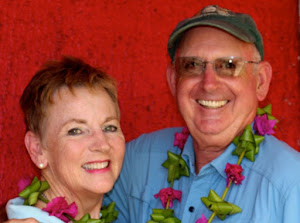 |
| Escalante Petrified Forest - Petrified Wood |
Tuesday, June 4, 2013 - The Last of Utah
After leaving Bryce Canyon we meandered through beautiful country where the layers of 160 million years were peeled away, exposing high plateaus, and cliffs so old that there were no animal fossils.We marveled at the petrified forest where trees were fossilized and between 80 and 100 million years old. The fossilized minerals shone like gems in the morning light. Every area we passed through bore the history of moving plates (at one time the land of the Escalante Petrified Forest was equatorial and moved north), covered by salt water, volcanic stones, layering of sedimentation, uplifting mountains, plateaus, carving rivers, erosion by water, wind, frost, sun, and heat.
Utah and much of the southwest is an amazing place for those of us interested in geology, earth's history, and the ancient indigenous peoples and culture of America. We spent a morning at the Anasazi Museum on our way to Escalante. These were the earliest of the ancients.
 |
| Capital Reef National Park |
 |
| Petroglyphs in Capitol Reef |
 |
| Shades of White - Pink |
 |
| Greys |
 |
| Millions of layers of Earth's History Revealed through Erosion |
 |
| The little water left in Glen Canyon near Hite is drying up - Can you see the water vaporizing? |
 |
| Crossing the Colorado River |
Our next stop was Natural Bridges. Here the water meandered aimlessly through the flat plateaus until the plateaus started to lift then the zig zag stream ran faster down the hills under cutting caves where the water powerfully flushed against the canyon's walls. Where a peninsula was created, the water would carve from two sides and eventually the bottom would erode away leaving a bridge.
 |
| Example of erosion on two sides cutting away. |
 |
| Sipapu Bridge |
 |
| Kachina Bridge |
 |
| Owachomo Bridge |
We continued on from Natural Bridges to Hovenweep, where we walked along the cliffs of ancient Puebloeans who took up farming where they could find water and built houses of sandstone along the tops of the cliffs.
 |
| The built square towers |
 |
| They incorporated large fallen boulders |
 |
| They built multi story apartment buildings |
 |
| Using rocks as their foundation they built dwellings with natural round curves |
We finally reached the bottom of Utah where the border meets New Mexico, Arizona, and Colorado. This is the only place in the United States where four states meet. It was really exciting to shed the the saying "I can't be in two places at once. We were in four places at once.
 |
| Fanny, Feet, and Each Hand in A Different State |
 |
| I think Russ's Nose is flying over New Mexico |
Of course we had to buy a few crafts from the Native American shops. Goodbye Utah...Onward to Colorado, Arizona, and New Mexico.
All is well with the Worrall Travel R's


















































